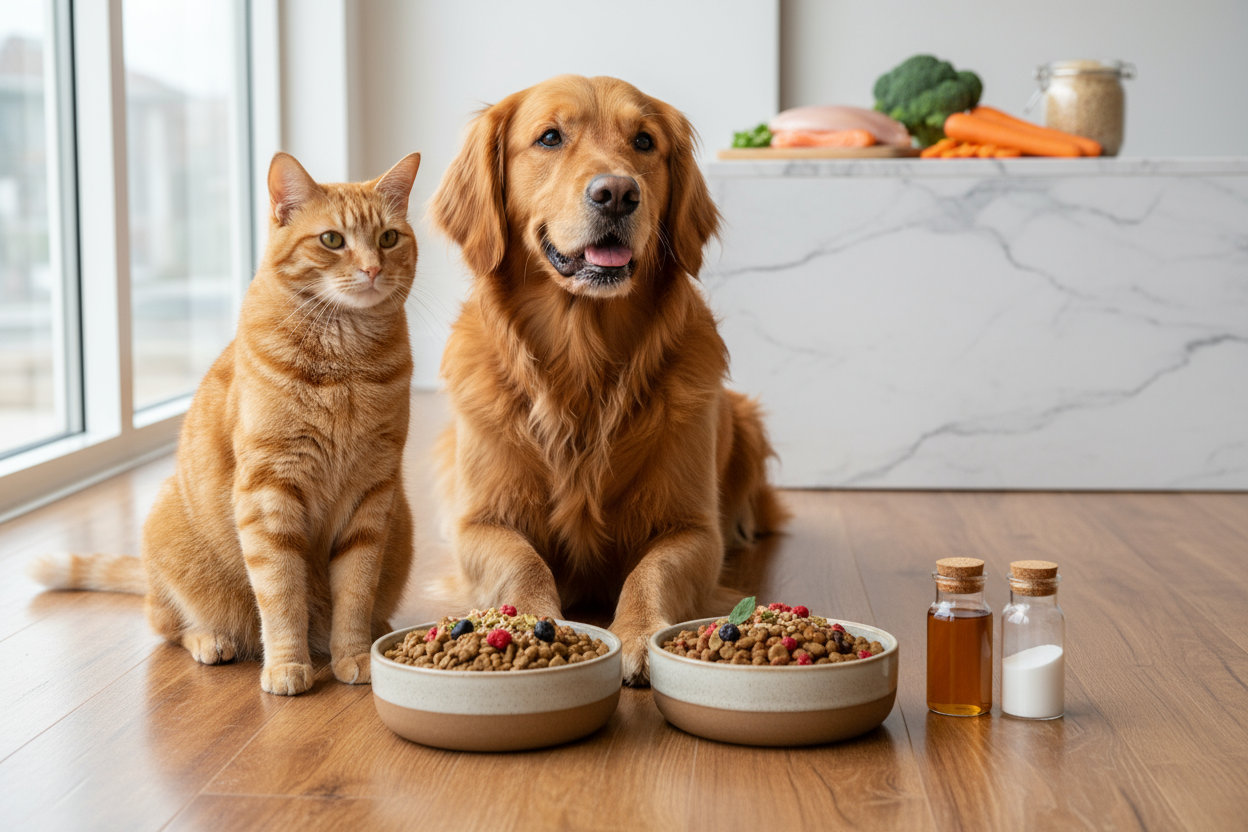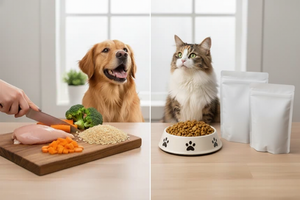Comprehensive Dog and Cat Nutrition: Feeding Your Pets for Optimal Health
Discover how to provide your canine and feline companions with balanced, species-appropriate diets that promote long-lasting health and vitality.
Key takeaways
- Dogs are omnivores requiring balanced protein, fats, and carbohydrates; cats are obligate carnivores needing high animal protein and specific nutrients.
- AAFCO standards guide the nutritional adequacy of commercial pet foods ensuring safety and balance.
- Life-stage diets differ: puppies and kittens need more protein and calories; seniors may require adjusted nutrients and joint support.
- Raw and homemade diets pose risks without veterinary guidance; supplementation should be cautiously applied.
- Several common human foods are toxic to pets and must be strictly avoided.
Table of contents
- Introduction: Understanding Dog and Cat Nutrition
- Species-Specific Diets: What Makes Dog and Cat Nutrition Unique?
- Essential Nutrients in Dog and Cat Diets
- Life Stage Nutrition: Tailoring Diet for Your Pet’s Needs
- Understanding AAFCO Standards and Pet Food Labels
- Risks of Raw and Homemade Diets
- Harmful Foods to Avoid for Dogs and Cats
- Food Allergies and Sensitivities
- The Role of Supplements in Pet Nutrition
- Practical Feeding Guidelines and Monitoring
- Conclusion: Nourish Your Pets with Confidence
Introduction: Understanding Dog and Cat Nutrition
Providing your pets with a balanced, species-appropriate diet is one of the most impactful ways to support their health and longevity. Dogs and cats have very different nutritional needs — dogs are omnivores that can digest both plant and animal matter, while cats are obligate carnivores, requiring nutrients found almost exclusively in animal tissue.
In this guide, we’ll break down the essentials of dog and cat nutrition, covering everything from key nutrients and AAFCO standards to potential hazards and supplementation strategies. Whether you're new to pet ownership or looking to fine-tune your furry companion’s diet, this resource will help you make informed decisions to promote their long-term well-being.
1. Species-Specific Diets: What Makes Dog and Cat Nutrition Unique?
Understanding Dogs as Omnivores
Dogs have evolved to eat a wide variety of foods. As natural omnivores, they can digest proteins, fats, and carbohydrates efficiently. While their nutritional range is broad, dogs still benefit from quality ingredients and careful formulation.
- Protein: At least 18% for adult dogs, and 22.5% for puppies (dry matter basis) to support muscle maintenance, immunity, and energy needs.
- Fat: A concentrated energy source that aids vitamin absorption and maintains healthy skin and coats.
- Carbohydrates & Fiber: Not essential but provide energy and promote digestive health with balanced gut flora.
- Essential Amino Acids: Dogs synthesize some amino acids, but a mix of plant and animal proteins ensures completeness.
Breed, size, age, activity, and health status influence the ideal diet. Tailoring nutrition to these variables is key for optimal care.
Cats as Obligate Carnivores
Cats are biologically hardwired to thrive on animal-based diets. Their bodies depend on nutrients only found in meat.
- High Protein Intake: Adults require at least 26% protein (dry matter), with kittens and nursing females needing closer to 30%.
- Essential Nutrients: Taurine, arginine, arachidonic acid, and vitamin A must come from animal sources as cats cannot produce them.
- Low Carb Requirement: Cats metabolize proteins and fats primarily and have minimal carbohydrate needs.
- Fat: Critical for energy, skin, coat, and overall health.
- Vitamin & Mineral Balance: A complete commercial feline diet covers all micronutrient needs.
Feeding diets lacking sufficient animal protein leads rapidly to deficiencies, making proper formulation essential. For further reading, visit the Merck Veterinary Manual or the Cornell Feline Health Center.
2. Essential Nutrients in Dog and Cat Diets
A nutrient-rich diet lays the groundwork for your pet's vitality. The six principal nutrient groups play critical roles in maintaining health.
Protein: Building Blocks of Health
- Provides amino acids for tissue repair, immunity, and growth.
- Minimum protein: 18% adult dogs, 22.5% puppies; 26% adult cats, 30% kittens and nursing females.
- Animal proteins are ideal for a full amino acid profile.
- Excess protein may strain kidneys in sensitive dogs, so balance is important.
Fat: Dense Energy and Fatty Acids
- Supplies concentrated energy and essential fatty acids.
- Adult dogs require ≥5.5% fat; growing dogs, ≥8.5%.
- Omega-3 (fish oil, flaxseed) and Omega-6 (vegetable oils) are vital for wellness.
- Symptoms of fat deficiency include dull coat and slow wound healing.
- Too much fat risks obesity-related health problems.
Carbohydrates and Fiber: Energy and Digestive Support
- Dogs convert carbs to glucose for energy, benefiting from soluble and insoluble fiber for gut health.
- Cats have minimal carb requirements; commercial diets may include small amounts.
- Fiber aids weight control and stool quality across species.
Vitamins and Minerals: Micronutrient Powerhouses
- Vitamins A, D, E, K, and B complex support immunity, enzymes, and other physiological processes.
- Minerals like calcium, phosphorus, zinc, iron, and copper aid bone strength, nerve function, and metabolism.
- Deficiency or excess causes illness; quality diets meeting AAFCO standards ensure balance.
Water: The Overlooked Essential
- Necessary for hydration, temperature regulation, nutrient transport, and waste elimination.
- Pets on moist diets may drink less, but access to clean water must remain constant.
- Monitor water intake, especially in seniors or ill pets; consult a vet with changes.
3. Life Stage Nutrition: Tailoring Diet for Your Pet’s Needs
Puppies and Kittens
- Rapid growth demands higher calories, protein, and fat per pound.
- AAFCO recommends 22.5% protein for puppies, 30% for kittens (dry matter basis).
- Large breed puppy formulas help control growth and skeletal health.
- Small, frequent meals support energy and digestion.
Adult Maintenance
- Steady protein and fat needs for baseline health.
- Most adults thrive on one or two meals daily.
- Feeding amounts tailored by breed, activity, and weight maintenance.
Senior Pets
- Metabolism slows; organ function and health conditions influence diet adjustments.
- Calories often reduced; protein tuned to preserve lean mass without kidney stress.
- Joint supplements like glucosamine are common additions.
- No official senior AAFCO profile exists, so veterinary guidance is essential.
For more details, review the Merck Veterinary Manual or the Cat and Dog Clinic of Bellevue.
4. Understanding AAFCO Standards and Pet Food Labels
The Association of American Feed Control Officials (AAFCO) defines nutritional benchmarks to ensure pet food safety and adequacy.
When reading pet food labels, look for:
- Nutrient Profiles: Minimum (and some maximum) protein, fat, vitamins, and minerals.
- Life Stage Statement: Indicates if food is suitable for growth, reproduction, or maintenance.
- Guaranteed Analysis: Lists nutrient percentages.
- Ingredient List: Reveals primary components of the diet.
- Feeding Guidelines: Suggests serving sizes, adjustable per pet need.
Choosing an AAFCO-compliant diet provides confidence that your pet receives foundational nutrition. For a deeper dive, see the PetMD Guide to AAFCO.
5. Risks of Raw and Homemade Diets
Raw Diet Concerns
- Bacteria Exposure: Raw meats may harbor pathogens like Salmonella or E. coli, affecting pets and owners.
- Nutritional Gaps: Homemade raw meals often lack essential nutrients without veterinary formulation.
- Injury Risks: Bones can splinter, causing choking or internal harm.
Some professionally designed raw diets are viable under strict veterinary guidance, but generalized feeding is not recommended.
Homemade Diet Challenges
- Homemade meals may be nutritionally incomplete or contain harmful ingredients such as garlic, onions, and grapes.
- Cooking improves nutrient absorption and safety by reducing pathogens.
- Always consult a veterinary nutritionist before starting homemade feeding.
6. Harmful Foods to Avoid for Dogs and Cats
Certain human foods are toxic — even in small amounts. Avoid feeding your pets:
- Chocolate: Contains theobromine, toxic to both dogs and cats.
- Grapes & Raisins: Associated with kidney failure in dogs.
- Onions & Garlic: Cause red blood cell damage leading to anemia.
- Xylitol: A sugar substitute causing rapid insulin spikes and liver failure in dogs.
- Alcohol & Caffeine: Harm nervous system function in both species.
- Macadamia Nuts: Toxic to dogs, inducing weakness and tremors.
- Bones (especially cooked): Risk choking and gastrointestinal blockages.
Refrain from giving table scraps and educate family members about these hazards. For guidance, see the Albemarle Animal Clinic.
7. Food Allergies and Sensitivities
- Food allergies, while not common, affect both dogs and cats, usually due to specific proteins.
- Symptoms: itchy skin, recurrent ear infections, digestive upset.
- Diagnosis involves an elimination diet under veterinary supervision.
- Hypoallergenic or limited-ingredient diets can help manage allergies.
8. The Role of Supplements in Pet Nutrition
Supplementation requires caution. More is not always better, and inappropriate use can cause imbalances or toxicity. Always consult your veterinarian before adding supplements.
Beneficial Examples
- Omega-3 Fatty Acids: Reduce inflammation; support skin, joints, and brain function.
- Glucosamine & Chondroitin: Help maintain joint cartilage, especially for older or large-breed pets.
- Vitamin E: Provides antioxidant protection to cells.
Most commercial diets already meet vitamin and mineral needs. Guidance from professionals ensures safe use. See the Cornell Feline Health Center and Albemarle Animal Clinic for more.
9. Practical Feeding Guidelines and Monitoring
- Choose AAFCO-Certified Diets: To ensure established nutritional standards.
- Feed According to Life Stage and Health: Customize based on your pet’s age, breed, and medical conditions.
- Meal Frequency: Puppies and kittens benefit from several small meals; adults generally do well with one or two.
- Provide Constant Water Access: Hydration supports almost every bodily function.
- Regularly Track Weight and Body Condition: Adjust feeding to prevent obesity or malnutrition.
- Use Vet-Supervised Diets: Especially for homemade and prescription foods.
Conclusion: Nourish Your Pets with Confidence
Feeding your pet a balanced, species-appropriate diet tailored to their age and individual needs is one of the best investments in their health and happiness. By understanding the unique nutritional differences between dogs and cats, adhering to reputable standards like AAFCO, and avoiding hazardous foods and supplements, you will support your pet’s long-term vitality.
Nutrition isn't one-size-fits-all. Consider your pet’s lifestyle, health history, and life stage — and always seek veterinary guidance when in doubt. With this thoughtful approach, you’ll be well-equipped to maintain your companion’s wellbeing from puppyhood and kittenhood through their golden years.
For trusted, AAFCO-compliant pet foods that align with your dog or cat’s needs, explore our curated selection at Petocart — your go-to resource for premium pet nutrition and accessories.
FAQ
Q: Why do cats need more protein than dogs?
A: Cats are obligate carnivores whose metabolism relies heavily on proteins from animal sources. They require a higher minimum protein level to maintain vital bodily functions and cannot efficiently use carbohydrates as energy.
Q: Can dogs safely eat carbohydrates?
A: Yes, dogs are omnivores and can digest carbohydrates well, which provide energy and dietary fiber for digestive health. However, carbs should be complex and balanced with other nutrients.
Q: Are raw diets recommended for my pet?
A: Raw diets carry significant risks, including bacterial contamination and nutritional imbalances. They should only be used under strict veterinary supervision and with professionally formulated recipes.
Q: How can I tell if my pet has a food allergy?
A: Common signs include itchy skin, chronic ear infections, and gastrointestinal issues. Diagnosis usually requires a vet-supervised elimination diet to identify the culprit ingredient.
Q: Should I give my pet supplements?
A: Most balanced commercial diets meet your pet’s nutritional needs, so supplementation is generally unnecessary unless recommended by a veterinarian for specific health concerns.








